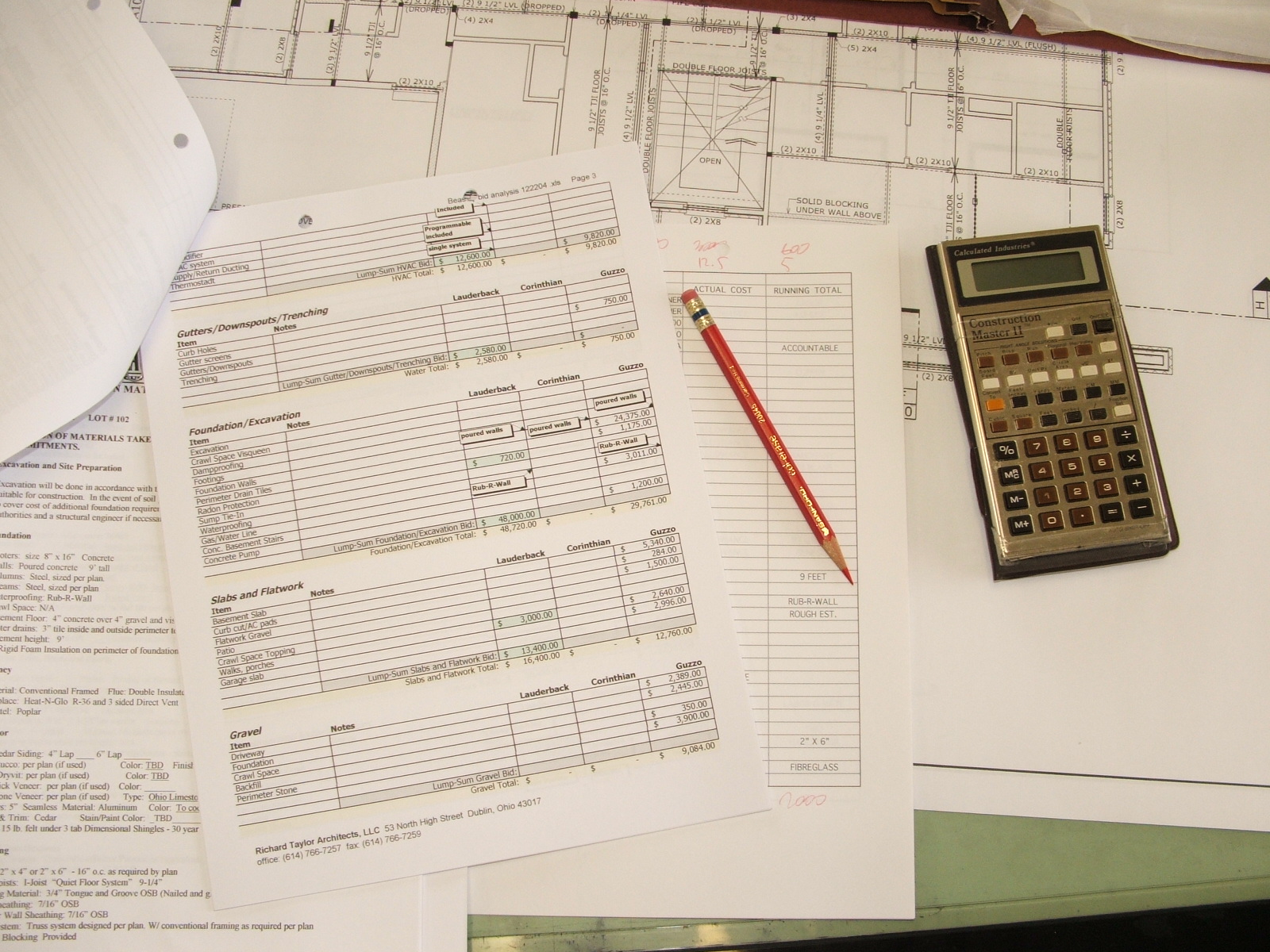
Get Bids From Several Contractors for Remodeling or New Home Construction Projects
You’ve heard this advice many times, right?: “Always get bids from several contractors for a home project”. Easy enough if your project is something simple like resurfacing the driveway, putting on a new roof, or painting the walls.
Those kinds of projects are easily defined, so they’re easy to compare prices on. But what if your project is more complex – a significant remodeling or room addition, or even a completely new house?
Bidding a large or complex project can be difficult, because there are so many components and so many different ways to build and finish it. And that can result in bids that are very far apart in price, or bids that are close together in price but don’t all specify the same things for the project.
Which makes the bids useless.
“Bidding” is simple when you’re buying a car, because you’re looking at nearly identical cars at different dealerships. You’ve done lots of research and you know exactly the car you want. It’s easy to see who offers you the best price.
But the new home or remodeling project you’ve designed is one of a kind. You have a good idea of what it might cost, but if you only get one estimate you have no way of knowing if that’s the best price around.
So how can you get truly comparable bids on a remodeling or new home project?
There’s only one reliable way, and that’s competitive bidding, a tried and true process that starts with complete, detailed plans and specifications for your project.
General Contractors and Subcontractors
I’m using the term “contractor” throughout this article, but I need to be a little more specific. A contractor usually has one specialty; a roofing contractor, for example. But for a larger project, you’ll need a general contractor. A “GC” oversees the entire project, and hires other specialty contractors to complete the work.
When you’re remodeling or adding on, the GC is called a remodeling contractor; when it’s a new home you’ll use a homebuilder. And the specialty contractors they hire are called subcontractors.
So the construction contract you sign will be with the GC, and he’ll hire (and pay) the subcontractors.
So far so good?
Choosing the Right Bidders
How many bids should you get?
I occasionally ask for prices from two GCs, but that isn’t always enough to give me confidence in the bids. On the other hand, four or five is too many to manage – and you’ll greatly decrease a contractors’ motivation to bid if he has only a 20% or 25% chance of getting the job.
Whenever possible, I prefer to get three qualified bids on any significant custom home or remodeling project.
Surprisingly, different general contractors bidding from the same set of drawings can come up with substantially different prices, especially when the drawings aren’t as detailed as they should be. That’s too often the culprit.
But just as important, and frequently overlooked, is your choice of contractors to bid on the project. You can’t have two large, professional remodeling contractors bidding against two guys and a pickup truck; the differences between their experience, professionalism, access to quality subcontractors, and dedication to their craft will make comparing their bids meaningless.
Likewise, contractors that aren’t used to competitive bidding won’t compare favorably with those that are.
That’s what happened when I began the bidding process for a home remodeling project we recently completed the construction drawings for, with a construction budget of about $240,000.
I recommended two qualified contractors to the owner – contractors I’d worked with many times before and knew well. The owner added the third bidder, someone their neighbor had used for work on their house.
I didn’t think they were a good fit for our project but the owner insisted, and we kept them on the list. Here’s how the three prices came out on the $240,000 project:
Bidder 1: $236,000
Bidder 2: $243,000
Bidder 3: $363,000
Clearly, something’s wrong with that last bid at 50% higher than bid #2 – a math error perhaps?
No, the contractor told me, that was his price. More importantly, it was the price he would expect to get on a similar project.
Imagine if the owner had chosen not to get three bids, and had only taken a price from bidder #3 – he would never have known that he was paying $120,000 more than he had to!
“Bidder #3” boasts a wall of awards, does great quality work, and has a long list of satisfied clients. And if you’re willing to spend a lot more to assure quality, they might be the right choice for you.
But with the help of your Architect, you should be able to chose three similar contractors, and get the same quality work at the right price. And with properly-detailed drawings, a good list of specifications, and three qualified, comparable contractors, your bids should come in reasonably close to each other.
Putting a Bid Together
Let’s start by assuming you’ve had your project designed by an Architect who’s provided you with three important documents: a complete, detailed set of bidding/construction drawings; a schedule of most of the finishes inside and outside of the house; and a “project manual” detailing the scope of the work; the quality and workmanship expectations; and a table of dollar allowances for the finishes and fixtures that haven’t been specified yet.
After each general contractor picks up the bid package from the Architect, he starts by making a series of take-offs. A take-off is an estimate of the quantity of a particular finish or material based on the plans.
So if the contractor estimates he’ll need 80 square feet of granite countertop in the kitchen, he’ll put down 80 sf on his spreadsheet. Next, he’ll multiply that by the cost of material and labor for the particular granite that’s been specified. If that cost is $50 per square foot, that’s a line item in his bid of $4000.
He’ll do the same thing for many of the other components of the project.
He’ll also send copies of the plans to his suppliers and subcontractors for prices on the work he’ll hire them to do. The window supplier will price each unit and send a total to the contractor, and the contractor will be responsible for figuring the price to install the windows.
The contractor will also get prices from his plumber, electrician, painter, flooring installer, etc.
Next, he’ll add line items for permits; insurance; temporary utility services, and dozens of other things he’ll need to complete the work. Finally, he’ll total them all up and add his overhead and profit.
It’s a time-consuming and nerve-wracking process for the general contractor because he’s got to get it right – too high and he won’t get the job. Too low and he’ll risk losing money.
Evaluating the Bids
So you’ve got your three bids in hand – now what?
Next is going through each bid in detail, and comparing all three side by side. You’ll find that no matter how detailed your drawings and specifications are, you’ll still find some differences between what the bidders have submitted.
One reason for that is the cost of subcontractors – some are more expensive than others.
Another is substitutions, when a sub or the GC substitutes something I’ve specified for a product he prefers to use, or one he can get a better price on. That’s fine, but I’m going to discuss that with the bidder before I accept it, to be sure we’re getting the quality we’ve asked for.
The biggest difference is often “markup” – the money the GC adds to the base bid to cover his costs and his profit. “Costs” include office expenses, insurance, and so forth, and can be very different between different contractors. I like to know what’s included in those costs.
I also expect our contractor to make a healthy profit on the job, because I want him motivated to do his best work and provide service when the project is done, but I also expect that profit to be reasonable.
So we need to go through each bid line by line, to verify they include everything needed to properly complete the project. That usually results in a few changes to one or more of the bids, which can change whose bid is the highest and whose bid is the lowest.
Now we have three truly comparable bids, and we can decide which GC to offer the project to. Usually that will be the lowest price, assuming we’ve done a good job of bidding to three comparable contractors. But I’ve have clients who chose the middle price, because they felt most comfortable with that contractor.
And that’s just fine, too.
Negotiating the Construction Contract
We’ve done a lot of work to get to this point, but we’re not quite finished yet. The purpose of the bidding process is to identify the contractor we want to work with. Now we’ve got to come to terms on the construction contract.
The “project manual” I mentioned earlier in this article helps with that, because it spells out many of the conditions we want our contractor to work under including working hours, progress schedule, and lien releases.
We may also ask the GC to rebid parts of his proposal to other subcontractors, if we think we can get a better price, or if we object to a particular sub.
But mostly we’ll be fine-tuning the final project requirements to help limit or eliminate changes in the field.
All of the above will change the final price that you and the General Contractor eventually agree on.
Bidding a significant remodeling or new home project is a complicated process, but it’s worth the time if your goal is to get the best contractor at the best price with few changes during construction.
And maybe you’ll save enough on the project to go out and buy that new car you’ve been doing so much research on.



Get at least three bids. By having more than one bid, anyone will be able to get a fairly accurate idea of what the work should cost. If the three prices are relatively close, we can usually feel safe taking the lowest bid. If one of the prices is much lower than the others however, it's important to evaluate the contractor carefully before blindly accepting the lowest bid. Suspiciously low bids usually mean inexperienced contractors, or may mean that he or she will use inferior materials.
Great article Richard! Very straightforward and clear. That helps me understand the process and role the Architect can play and how much of an Advocate He or She can be for the client.